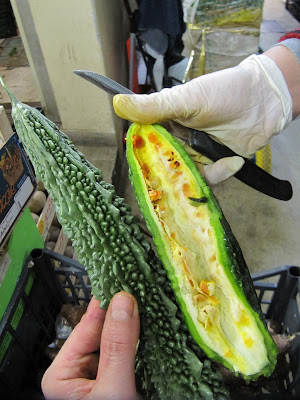Bitter melon is what this fruit is officially named and makes for some interesting and raunchy conversation. Originating in Southeast Asia, China, Africa, and India, this particular selection of bitter melon was cultivated in the province of Arezzo (about 80 km/50 miles from Florence). Italians generally don't eat it, but the immigrants buy it and fry it. It is a cugina (cousin) to the cucumber, melons, and squash families. And for those of you who don't know, it is technically a fruit because it has seeds. A fruit can also be a vegetable, but a vegetable can never be a fruit. While we're on the subject, I'll tell you that tomatoes; cucumbers; squash and zucchini; avocado; green, red, and yellow peppers; peapods; and pumpkins are all fruit, not vegetables.
The outside has an interesting texture -- long, delicate, rubber-like to the touch, with warts and ridges, and a bitter flavor -- whereas, inside the fruit has a pulpy cavity with ripe, red seeds that are slightly sweeter to the taste. (No, I didn't taste it! I trust my friends who described and tasted it in my presence, thank you.) It comes in a variety of shapes and sizes.
Bitter melon is known to have medicinal uses. Among the many uses, it stimulates sluggish digestion. I could imagine it would stimulate something. Clinical tests revealed links to aiding in the treatment of HIV and cancer as well as type-II diabetes.
Throughout Italy, bitter melon is more commonly known as pisello di coccodrillo, which I don't think I am permitted to translate on a public website.
How creative are you? How would you prepare this fruit? Do you eat it raw or cooked? Share your recipe ideas...
-- Josslyn "Giosalina"Firenze, Italia










hi there! I have been living in China for some years now and, according to my local and japanese friends alike, they told me to eat it pan stirred or, if you cannot handle the bitterness (which i personally find good, refreshening and not too bitter), i should cook it for not less than 20 minutes and then use it for anything: solo, in dishes, cool, hot.
ReplyDeleteI have had a hard time finding pisello di coccodrillo in italy but when i am here i love to indulge mainly because i know it really helps to clean the blood from lypids, excess toxins and has all sorts of benefits. just don't exaggerate. just like for anything.